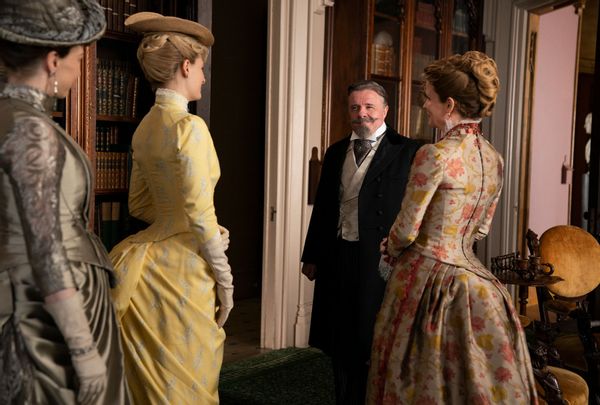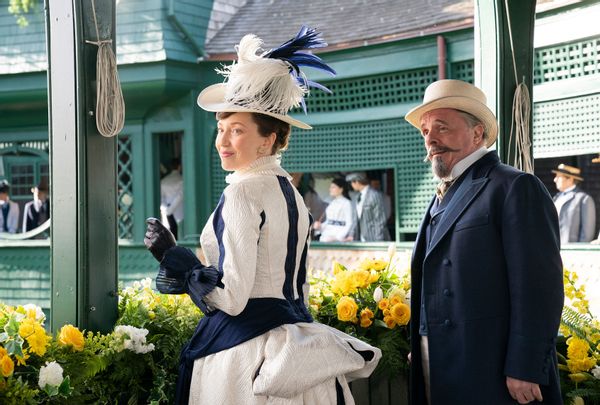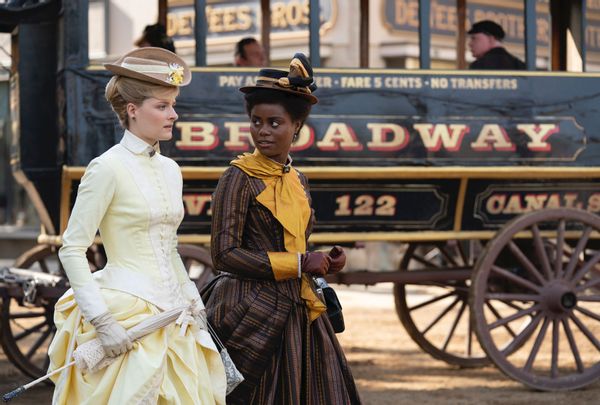
When I was very young, I started having terrible and specific nightmares. Eventually, my parents figured out that my babysitter was letting me watch soap operas with her, and that was the source of my dreams of drownings, shootings, marriages and twins. I've never much been interested in soap operas since.
So maybe I am not the target audience for "The Gilded Age," Julian Fellowes' New York City high society drama set in 1882. Centering on rich families, particularly two houses across the street from each other, the episodic HBO show feels more "Days of our Lives" than Fellowes' past historical hit, "Downton Abbey." But while Christine Baranski steals the scenes, as always, and Carrie Coon is foreboding as a new money matriarch, one character in particular did stick out to me. Literally.
The bustle.
Has so much ever been riding on one small piece of clothing? Costumes indicate social status, but can also, in a show with so many characters when so many of them look alike, help us differentiate roles.

The young ward character Marian Brook (Louisa Jacobson) wears yellow and pale blue silks, like Snow White in a corset. Marian's aunt, Baranski's formidable widow, is fond of rich, royal tones with black lace. Peggy Scott (Denée Benton), a young Black woman trying to make it as a writer, prefers plaids and jewel tones. While "Gilded Age" has, so far, not explored the inner lives of the servants as much as its older sibling "Downton" did, the ladies maids and housekeepers also sport modest bumps below their uniform black.
What unites all these women across social strata (and the dirt street), upstairs and downstairs, is the bustle.
Related: The heroes of "Hawkeye" dress like us
"The Gilded Age" focuses on two households, old money sisters Agnes Van Rhijn (Baranski), the widow of a rich man to whom she alludes darkly, and Ada Brook (Cynthia Nixon), who never married, along with Marian, the Pennsylvania niece they take in after her father dies and leaves her penniless. Typical Henry!
Across the street, a new-fangled mansion has gone up, orchestrated by railroad tycoon George Russell (Morgan Spector) and his wife Bertha Russell (Coon) who runs the show. They have grown children: golden boy Larry (Harry Richardson) and petulant Gladys (Taissa Farmiga). There are dozens of other characters, including the servants of both households, widows, ostracized women, women running charity bazaars, and Clara Barton, founder of the American Red Cross.
And then there is the bustle.

According to Smithsonian Magazine, the bustle was patented in 1857, but didn't come into popular fashion for another decade. A padded device designed to expand the look of skirts below a person's waist, the bustle was tied or strapped on, made of muslin and wire, or mohair or stiffened horsehair or springs or braided wire.
Regardless of specifics, it was artificial and extra, meant to exaggerate an unnatural body shape: flat (business) in the front, highly accentuated (party) in the back. And like corsets, crinolines (incredibly flammable skirt cages that resulted in the burning deaths of thousands of women) and hoop skirts, the bustle wasn't the most ergonomic.
Smithsonian Magazine quotes from a letter written to the Boston Medical and Surgical Journal in 1888, reporting, "The woman with a bustle can never sit down in a natural position." The letter goes on to discuss the severe backaches of women of the era, particularly those women who had to remain seated.
So much of the history of women's fashion is about discomfort and restriction — and so much of "The Gilded Age" is about keeping up appearances, conniving to be accepted into polite society, plotting to keep a man away from the woman he loves. There's not much "natural" about it.

Although disguised, the bustle's impact cannot be hidden. Like Peggy's writing, which will not be denied, despite misogynoir and other obstacles in her path, it will be heard. Or at least, noticed.
Ada's character is all about shrinking. Her spinster role is one of naïveté, innocence and inexperience. She's unable to act in her own self-interest (or to take any action at all). Marian is considered shocking because she dares to make a joke every now and then, or darkly comments astutely on a situation. "Really Marian?" Aurora Fane (Kelli O'Hara) remarks to the young woman at a luncheon when Marion suggests new money barons might build a better opera house than the decrepit, established one. "I can see we're going to have to take you in hand."
The bustle makes no such pretenses. The bustle is loud and proud. You can hear it coming in the rustling of the women's skirts, and wearing it changes their walk to a sway. Even hidden by those voluminous skirts, you know it's there, the (almost) silent partner in a shady business deal.
It takes up space, announcing itself, dictating how the actors must stand or walk together, keeping respectable social distance between Bertha Russell and Nathan Lane's odd Yosemite Sam-ish character Ward McAllister, for example. As the letter to the Boston Medical and Surgical Journal explains, women must carefully sit down when in a bustle, gathering their skirts. Even the ordinary movement of sitting is extra deliberate, planned. The women must sit sideways; as in their lives, they can't be at the center.
But the bustle also folds up when needed. It was meant to, so the women can actually sit, even if not especially comfortably. To a man not encumbered by such artifice, he might forget the bustle is there while dining with female companions most definitely wearing them. Like staff sliding through doors completely disguised by wallpaper, the bustle is meant to disappear.

Even Gladys, struggling to be taken seriously as a young adult by her mother, who has not yet allowed her to come out into society, wears a respectable bump at the back of her frocks. The bustle may be the only thing many of the women in "The Gilded Age" have in common: an uncomfortable, open secret below their clothes.
Want a daily wrap-up of all the news and commentary Salon has to offer? Subscribe to our morning newsletter, Crash Course.
Perhaps the most interesting fashion fact of the world of the show is that its most prominent item will be short-lived. The bustle, as Smithsonian Magazine writes, "went out of fashion around 1888." After growing to larger and larger proportions, it deflated like a balloon. "The Gilded Age" is set in the early 1880s, and while the show has already been renewed for a second season, it's unclear if it will fast forward in time, as "Downton Abbey" did.
As for the bustle and what we can expect from it, the hardest-working, unsung hero of "The Gilded Age"? It's going to get very big, and then it's going to go away.

More stories like this:







